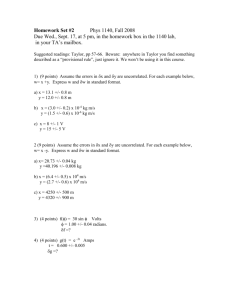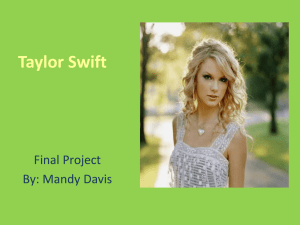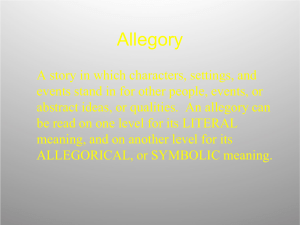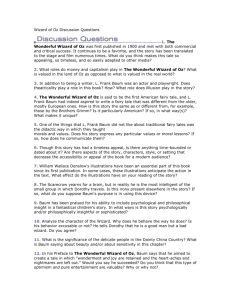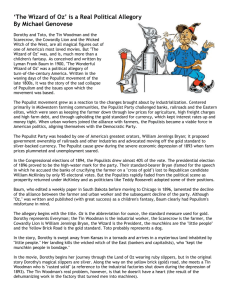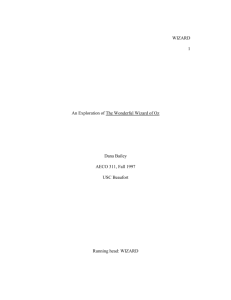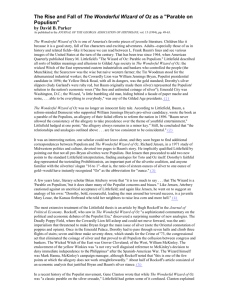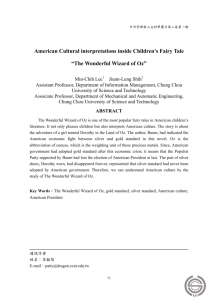Running Head: The Meaning Behind The Wizard of Oz 1 The
advertisement
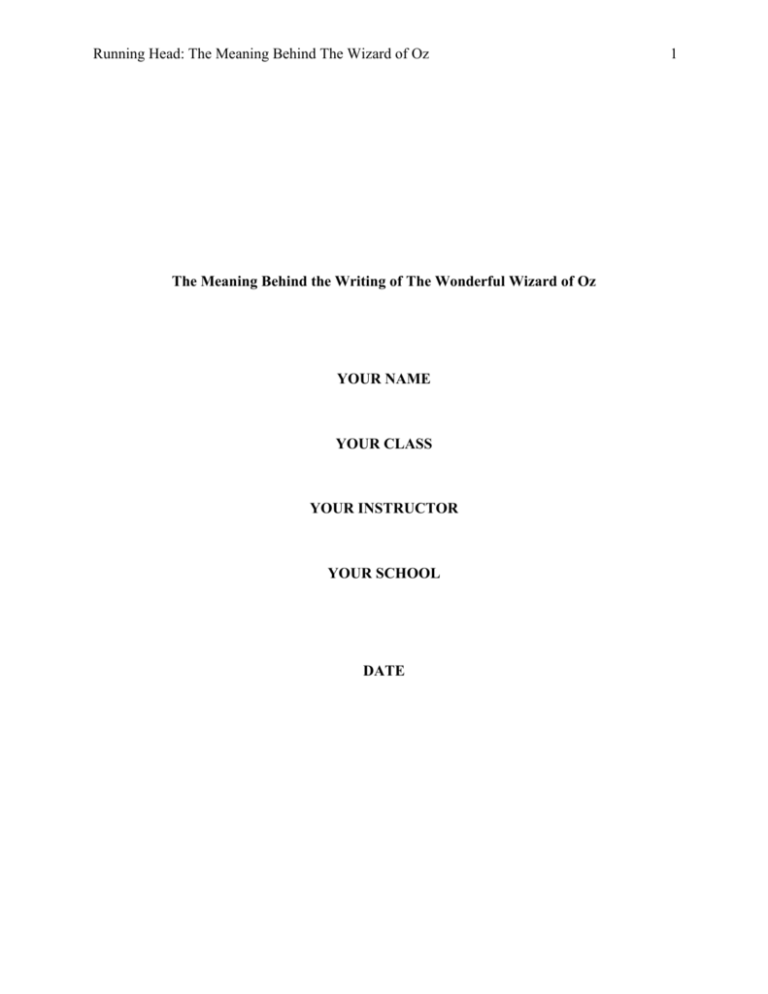
Running Head: The Meaning Behind The Wizard of Oz The Meaning Behind the Writing of The Wonderful Wizard of Oz YOUR NAME YOUR CLASS YOUR INSTRUCTOR YOUR SCHOOL DATE 1 Running Head: The Meaning Behind The Wizard of Oz 2 An examination of characters, settings and plot in The Wonderful Wizard of Oz by Frank Baum was presented in the article “Money and Politics in the Land of Oz” by Quentin Taylor. Mr. Taylor claims that, like many classic literary pieces, things are not what they seem. He asserts that events and personalities as well as political ideas of the late 1800’s are intentionally represented by the characters and the plot of the story. In all honesty, as I read the essay, I was intentionally looking for the primary argument. Several times I thought I had found it, but it wasn’t until the last paragraph that I realized I had known the argument all along. First, Mr.Taylor presents and defends the conclusion that The Wonderful Wizard of Oz was written intentionally as an allegory. Second, he presents and defends the conclusion that The Wonderful Wizard of Oz was written as a piece of entertainment (as the author had insisted all along). While some of the supporting evidence appears to be oppositional, it is not detrimental to the author’s (Quentin Taylor) purpose. Sound statements regarding the political climate of the turn of the century clearly back up the possibility that Frank Baum intentionally wrote The Wonderful Wizard of Oz primarily as an entertaining piece of literature using the mechanics of allegorical story telling. It doesn’t appear to be of much importance as to whether he intended to conceal a message in the text or not. Did Frank Baum protest too much when he stated that his children’s book was written solely for children? Did he have an elaborate plot to create an elaborate joke on the public or was he a secret political fanatic? Again, there is not much evidence to show that even if he did, it made much difference. For example, as Mr. Taylor inserted correlating evidence to illustrate the political references, he stumbled upon the use of William Jennings Bryan in more than one way (as the Lion and the Wizard). Mr. Taylor explains this as representing two sides to the politicians personality. Various elements of the political atmosphere are repeated over and over. The idea of silver and gold and their significance at the time, the devastation of the Midwest by harmful weather conditions, the attitude of the politicians toward the “little man” and the American Indian are among some of the repeated themes in the story which Mr. Taylor discovers. Mr. Taylor’s knowledge of the political climate of the United States in the late 1800’s is extensive, easy to follow and reasonably analytical. Although the points he made were often quite small and seemingly insignificant toward his greater purpose, they were interesting and contributed to the overall historian’s perspective toward the piece. While possibly a weakness in literary presentation, it was occasionally unclear as to whether Mr. Taylor was presenting his own opinion, or whether he was joining with other authors and agreeing with their opinions or if he was critiquing the opinions of others. Running Head: The Meaning Behind The Wizard of Oz 3 Mr. Taylor seemed to introduce a goodly amount of information that while true, was not directly involved in the argument he was presenting. For example, he briefly mentions that Hollywood changed the shoes from silver to ruby but gives no reason or support of these facts, leaving the reader a little puzzled over the mention of the fact. He seems anxious to jump on the comparison to Populist Party bandwagon and to have his reader do so as well. Knowing the conclusion, I thought that this was a bit of a red herring for the reader. Another relatively unimportant bit of research was whether or not Baum was a Populist, Democrat or neither. It seemed that Mr. Taylor was going to use this with his conclusions about the underlying symbolism of the book, but he didn’t. His conclusion, from out of the blue, was that no one could tell and Baum took the secret (if there was one) to his grave with him. Unfortunately in his quest to present all previous opinions as to allegory or not, Mr. Taylor has created a mish mash of statements with no conclusion, leaving the reader scratching his head as to the purpose for the presented research. Skipping from previous author’s opinions to a new approach, Mr. Taylor finally gets to the point. If the story can be fit into the definition of an allegory so perfectly, shouldn’t the likelihood that it was written as an allegory be concluded? To defend his premise of political allegory he calls upon previous arguments from noted authors and adds in his own supporting evidence or comments. To defend his conclusion that the story is strictly a piece written for entertainment he uses a type of cancelling out methodology … it is not a pro Populist piece nor is it an anti Populist piece, therefore it is not a teaching piece and must be simply an entertaining piece. Therefore, the primary argument was that because The Wonderful Wizard of Oz was not a pro-Populist piece nor an anti-Populist piece there was no teaching (definition of a parable) and thus the piece was strictly entertaining. References Taylor, Quentin, “Money and Politics in the Land of Oz”, The Independent Review, v. IX, n 3, Winter 2005, pp. 413-426.





